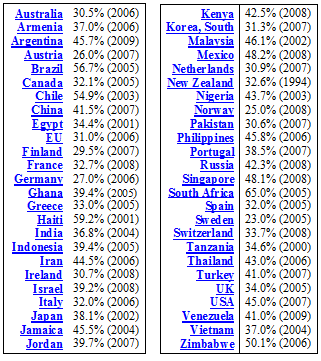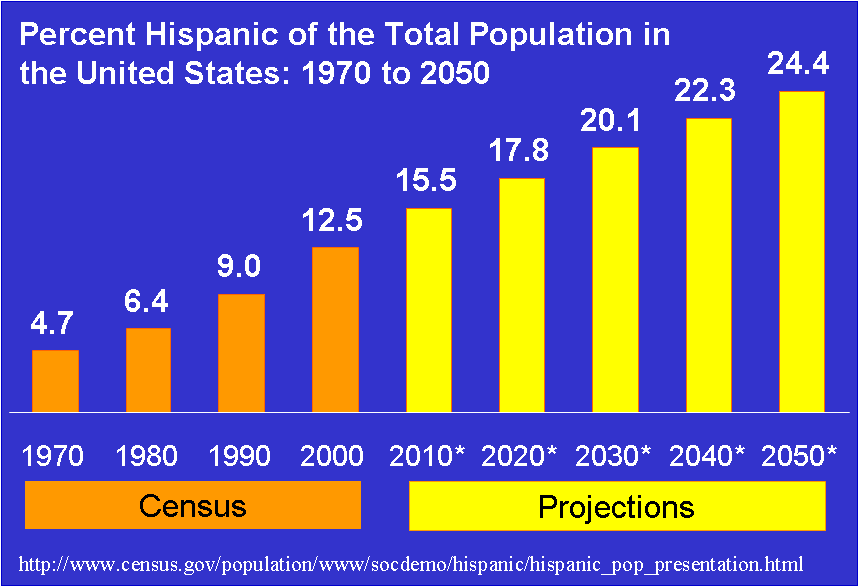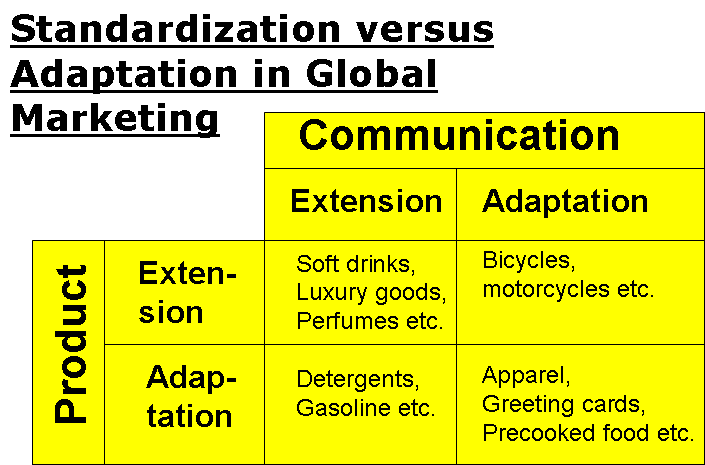The return of global strategy? (page 280)
For global companies,
the pendulum seemed to swing away from global strategy towards
localization. Do you feel the pendulum is now swinging back towards
global strategy, and why?
|
Recall the Bartlett and Ghoshal typology that distinguishes
multi-divisional firms based on whether the strategy is local or
global
and the organizational structure is
decentralized or
centralized.
It is helpful to begin by identifying different strategic perspectives:
multi-domestic, regional and global. Localization has been stressed,
especially in consumer markets, but global product divisions point more
towards global strategy. This makes it seem that global strategy is
coming back into its own, but with some provisos. |
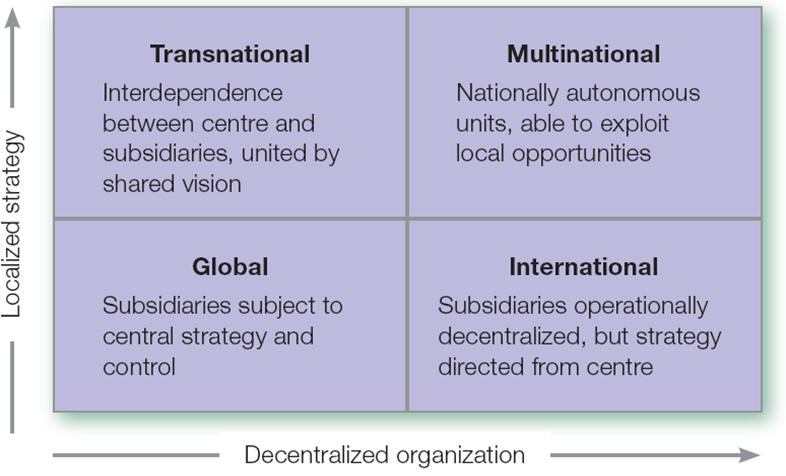 |
|
Some
relevant points:
-
Global
product categories and global brands lend themselves to global
strategy. However, adaptations must be made for local conditions and
preferences.
-
Global
media, including the internet and satellite TV, are becoming more
pervasive. Internet advertising is growing rapidly, thanks largely
to the search engines’ efforts to increase advertising. This
facilitates familiarity with brands, logos and products globally.
However, the brand owner is likely to adapt products for local
markets, and also tailor marketing to local markets.
-
Paradoxically, the internet facilitates the localization referred to
in the previous point, as local language websites operated by global
companies now abound. Google is available in dozens of languages.
|
Developing and emerging markets
(page 288)
What factors should firms prioritize when
contemplating expansion into these exciting new markets? What are
their disadvantages in comparison with developed countries?
|
What factors should firms prioritize when contemplating expansion
into these exciting new markets?
-
Rate of
economic growth and regions/cities in which the growth is
concentrated.
-
Degree of
industrialization and where it is happening – These are areas where
consumer spending is going up, in keeping with wages.
-
Levels of
education and urbanization – These are indicators of a growing
middle class, whose members are spending along the lines familiar in
developed consumer societies.
-
Proportion of the population which can be considered affluent enough
to buy the firm’s products – This may be quite
low at present, but if it is rapidly growing, market entry is
justified.
What are their disadvantages in comparison with developed countries?
-
Political risk: Many of these economies are politically
unstable, and many tend towards authoritarian political systems.
-
Social
instability: Social and ethnic divisions can lead to unrest
anywhere, but are a bigger risk where rapid urbanization is taking
place, and where poverty is extensive.
-
Infrastructure: Infrastructure tends to be weaker in developing
countries.
-
Sound
legal system: The legal environment is important for the
protection of property, including intellectual property rights.
|
Emerging market entry
(page 295)
Which entry strategies are best
suited to developing and emerging markets, and why? Give examples in
manufactured products and in retailing.
|
Strategies suitable for developing
and emerging markets depend largely on the industry.
-
Production under license is
appropriate for manufacturers, with the proviso that supervision of
quality and working conditions can be maintained. However, leakage
of IP is a risk.
-
FDI in a greenfield site would be
more attractive if leakage of IP is a risk. This allows greater
control over production, and also distribution and marketing,
assuming that the local market is targeted.
|
•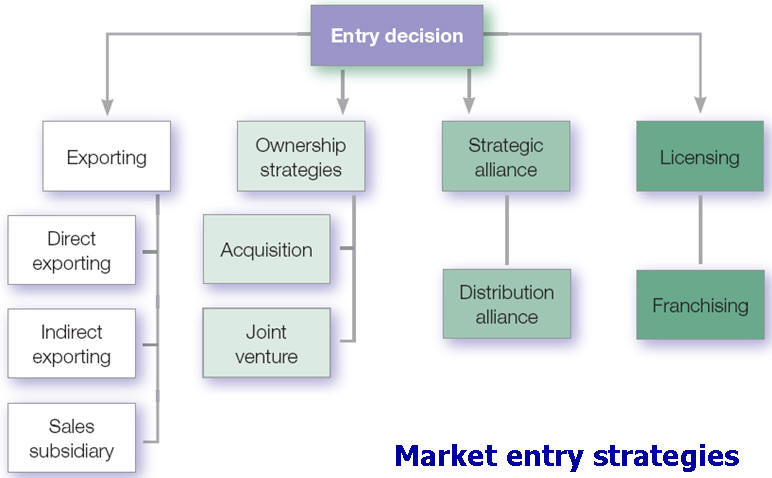
|
|
This
is true of manufacturing as well as retailing. In many countries,
such as India, the foreign investor is required to use the joint
venture with a local company. Acquisition is favored by many
retailers. This allows the foreign investor to starting gaining a
return immediately. However, the target company must be selected
with care.
|
Waning of the global
brand (page 300)
Global brands
have faced consumer resistance in many markets, from consumer who
prefer low-cost own brands and from those who object to the economic
power and practices of large global companies. To what extent do you
feel that the reputation of global brands is declining? Give
examples.
|
It is hard to expect any unanimity on
this question. Note that it asks about the declining reputation
of global brands. It is worth considering the elements of a good
reputation for a brand, before looking at whether global brands are
declining in reputation.
Some relevant points:
-
The growth of own brands has dented the
reputation of some global brands, as consumers feel they are asked
to pay a premium just for the brand. This has been true in
pharmaceutical products, compared to generic medicines (see CS12.2).
|
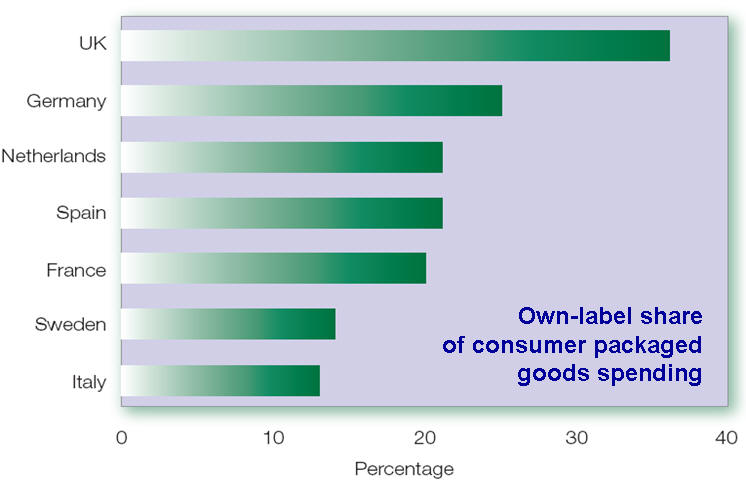 |
-
Some global brands are perceived as too
dominant, and in a position to compete unfairly. This is associated
with anti-globalization views. Microsoft is an example.
-
Some global brands are perceived as
essentially American, and become the focus of anti-American
sentiment. McDonald’s is an example.
-
Some global brands have been associated with
outsourced production in low-cost countries with poor labor
conditions and weak protection of human rights. This association can
damage the brand in the eyes of many people.
|
Price sensitivities
(page 306)
Price discrimination policies
operated by global companies are becoming more widely publicized,
largely thanks to the internet. Do you feel there should be greater
regulatory control over the pricing of sensitive products such as
medicines and essential foods, or should market considerations be
allowed free rein?
|
Many different views exist on this issue, and
students should be able to discuss it from their experience in their own
country. Some might argue that market forces should have free rein in
all products, but, in practice, most governments see pricing of
essential goods as an aspect of social policy, although they differ on
their willingness to intervene.
The following are some relevant points:
-
MNEs see pricing in terms of national markets,
and set prices according to factors in each market. However, this
strategy is becoming undermined as price differentials become widely
known. Both individuals and businesses in countries where prices of
particular goods are high, are naturally inclined to seek out
cheaper locations to buy them. After all, the global company follows
a similar strategy, sourcing and producing in the most advantageous
location.
-
In some products, such as software and DVDs,
the trade in counterfeit products is booming in some markets where
the official prices are high. It has long been said that in China,
there are more people using pirated copies of Windows and Office
software than legitimate ones. In this situation, even if Microsoft
lowers its prices (as it has done), it is still difficult to sell
products, as people are accustomed to paying nothing.
-
In essential goods, governments may intervene
in various ways. Some control prices in essential products,
effectively setting a cap on prices. Governments in emerging and
developing countries have applied caps to essential foods and energy
prices. This helps to cushion the effects of global prices rises in
commodities (the consumer in a poor developing country typically
pays half or more of his/her income on food). A difficulty is that
this policy can lead to shortages of supplies and the emergence of a
black market (the producers cannot make enough money producing for
the legitimate market to stay in business).
-
Branded medicines are only affordable by the
most affluent, mainly those in developed economies. In fact, even in
these economies, resistance to high prices is an issue. Where there
is a national health service, it can exert pressure for lower prices
in its market; it can also threaten to use generic alternatives
where possible. In the US, there is now much resistance to the cost
of medicines, which is beyond the means of many. The pharmaceutical
companies are therefore faced with a dilemma, as is the government.
This was an issue in the 2008 presidential election campaign.
|
Marketing codes
of ethics
(page 311)
Devise a brief code of marketing
ethics, consisting of the 10 principles you feel are most important
in international marketing.
|
You are encouraged to design your ten principles
as you see fit, not copy from internet sources! Principles which could
figure in the list:
-
Comply with the law of the country in which
the firm’s products are sold and marketed.
-
In advertising, accurately and honestly
describe products, refraining from any false or misleading claims
about their qualities, price, content or performance.
-
Where products are particularly designed for
children (e.g. toys) adhere to the highest standards of testing
components and finished products, even though national law has lower
standards.
-
Ensure that all involved in marketing directly
to consumers adhere to principles of honesty and fairness.
-
Where products are potentially harmful if
taken in excess (such as alcoholic drinks or even junk foods),
emphasize responsible use in advertising.
-
Where there are reasonable suspicions that a
particular product is harmful (such as contaminated food products),
make a public announcement immediately and cooperate with
authorities.
-
Avoid marking up prices of products
excessively.
-
Adhere to principles of sustainability in
packaging.
Many other principles could be included. The lists
of all in the seminar group could be compared. How many principles
feature repeatedly? These are likely to be the core principles which
participants feel are important.
|
It could be
argued that brand image can be damaged by unethical marketing,
although ethical marketing does not necessarily enhance brand image.
The MNE would be advised to see ethical marketing as essential to maintain
brand image, in order to avoid the damage which can be caused by cases of
unethical behavior. This is rather a defensive strategy, but possibly a
realistic one.
MNEs now
generally accept that they are active participants in the communities in
which they operate, whatever the location. While they may view their
activities chiefly in economic terms, economic activities are increasingly
mingled with social, ethical, environmental and political issues. For this
reason, it is arguable that companies which manage these interactions with a
view to social as well as economic goals will build more sustainable
long-term strategies in host countries.
The implications
for global strategy are that local CSR and stakeholder concerns can bring
positive benefits. Moreover, for MNEs, reputational damage in one location
can lead to negative perceptions of the company in terms of global
reputation.
Assess China as a potential market in terms of the three
levels of analysis presented in the previous section: macro-level factors,
consumer markets, and micro-level product markets?
-
Macro-level factors:
China enjoys rising GDP per capita and high economic growth rate. Its
growing urban middle class is a tempting market. However, these factors
are unevenly distributed: rural areas have not participated in the
rising incomes and growth to the same extent as urban areas.
-
Consumer
markets:
China’s new consumers are eager to acquire the items associated with
Western lifestyles, including consumer electronics, cars, holidays, and
meals out. Eating habits are changing in the urban areas: people are
eating more western-style foods, including meat.
-
Micro-level product markets:
China is an attractive market for foreign MNEs, but in most product
markets, existing domestic firms are active, and the foreign MNE can
expect a fierce competitive environment. Retailers such as foreign
hypermarkets have entered China. Because of their size and scale
economies, they can compete on price with smaller local stores. They
also offer a great variety of products under one roof. However, Chinese
consumers are highly influenced by price, and local supermarkets are
adept at maintaining competitive prices. Similarly, in car
manufacturing, Chinese makers, such as Chery, compete successfully
alongside the models offered by the foreign joint ventures.
How does China’s rich-poor divide impact on the growth in
consumer markets?
It is a mistake to view China as a single market. The
rich-poor divide is mainly based on the differences between urban and rural
populations. However, regional differences are significant. The developed
urban coastal areas are richer than inland cities, although urban areas
generally have growing numbers of middle-class consumers. Western entrants
have focused on the coastal areas, but future growth in consumer markets is
likely to come from the more inland cities. Consumer markets in these cities
are diverse, reflecting regional differences in tastes. These consumers
cannot be assumed to be attracted to Western consumer goods as they become
richer. China’s consumers are becoming more affluent, but their location and
cultural environment help to determine consumer markets, in addition to
their growing incomes.
Why have hypermarket retailers flocked to China?
-
The size of
the Chinese market is the main attraction. Although affluent consumers
are still in the minority, the potential for growth makes it worthwhile
for Western hypermarket retailers to invest.
-
Hypermarket
retailers benefit from economies of scale. Where the market is
potentially large, as in China, their advantages become more pronounced.
-
China is
still experiencing economic growth rates of about 8%. This is not as
high as those of the last two decades, but is till much higher than the
more mature markets of the US and Europe.
-
Hypermarket
retailers have met resistance in some European markets because of their
size and perceived detrimental impact on local competitors. Hence, their
scope for growth in these markets has tailed off. In addition, planning
permission for the large sites they require often raises objections.
Their moves into emerging markets such as China therefore represent
opportunities in an environment where the formal retailer sector is less
developed.
-
Once one
hypermarket retailer has entered China, such as Carrefour, its main
rivals feel compelled to follow.
Large media companies are now recognizing the opportunities
in Spanish language output. An example is GE, which bought Telemundo. These
companies see the benefits of in-house production, in contrast to the
imported content used by Univision. Other aspects of strategy are targeting
wider global audiences and creating accompanying websites which carry
advertising. Owning their own content gives the companies flexibility to
exploit a variety of formats. Success in Asia opens up the prospect of much
bigger audiences, and these are audiences with considerable spending power
as well as widespread internet access.






